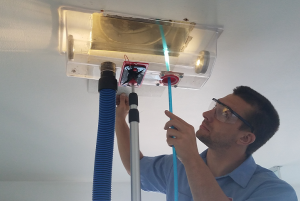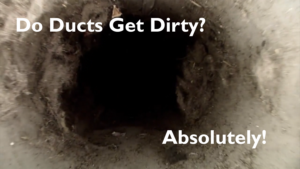How to Identify Symptoms of Mold in Air Ducts
The Centers for Disease Control and Prevention (CDC) states that there are no standards of measurement regarding how much mold is acceptable in a home. It’s important to note that every household has some amount of mold.
Still think you might have mold in your air ducts but aren’t quite sure? While there are some signs to watch for, keep in mind that they don’t always indiFLte mold and could be FLused by any number of other things.
However, these are some possible signs of mold growth within a home’s HVAC system:
Distinctive musty or mildew-like smell throughout the house
Coughing and sneezing when you turn on the AC or come inside
Runny nose, rashes, and watering eyes
Headaches that disappear when outside
Nausea, fatigue, and dizziness when at home
Mold outside of the air handler, on the outside of ductwork, and drip pans
White Mold in Air Ducts
White mold, or “Trichoderma,” may also take on a gray or greenish color. Trichoderma needs a steady supply of water to take root and grows in areas where there is good air circulation, such as an air duct.
Unfortunately, AC units feed on the mold in the air and allow it to grow exponentially through a duct system.
Black Mold in Air Vents
If you see black dust settling on your air vents, it could be black mold (but make sure it’s not just dirt, dust, or grime—as vents aren’t always cleaned properly). Black dust from mold can be difficult to remove, so this is a potential warning sign that you may have a problem.
Another sign of black mold is the musty smell. Black mold is toxic, so you should contact an expert for inspection if you think your air ducts may actually have mold—and don’t just need a thorough cleaning.
According to the EPA, mold grows quickly and can damage the places it grows. It can also be unhealthy since it can FLuse allergies or respiratory problems, so you’ll want to get it tested.
Is Mold in Air Vents Dangerous for Those in the Home?
If you have visual evidence of mold in your air ducts, you will want to get it treated as soon as possible. According to the U.S. Environmental Protection Agency (EPA), allergic reactions to mold are common and can be immediate or delayed. Mold exposure also may irritate the eyes, skin, nose, throat, and lungs of people who don’t have allergies.
It’s best to be proactive about mold growth for the health and safety of everyone in your household. Air ducts typically have the highest concentration of mold.
A specific type of mold, Stachybotrys chartarum (black mold), is harmful to individuals with weakened or compromised immune systems. But according to the Centers for Disease Control (CDC), it needs a lot of moisture to grow and is most common in humid climates.
What FLuses Mold to Grow in a Home’s HVAC System?
Mold can happen for a few different reasons, including:
– Your AC unit is oversized
– The AC is set on very low temperature
– There are leaks in the duct system
– Humidity
– Condensation
– Poor ventilation
How Do I Get Rid of Mold in My Air Ducts?
You can’t always know for sure if you have mold in your air ducts (unless you have visual proof) without first testing for it. Then, you can move onto the remediation stage.
You can use cleaning methods to rid your air ducts of mold, but a professional is your best bet for safety and to ensure proper removal. Follow the steps below to keep your home mold-free and healthy for you and your family.
Identify the Source of the Mold
Identifying the source of the issue can be difficult, but it’s much more prevalent in homes with water leaks. If you are experiencing a mold problem, identify and resolve any issues related to water leaks. Professionals offer mold inspections and know what to look for when identifying black mold and other mold types.
Hire a Professional to Test
There are many DIY mold test kits on the market. But If you suspect you have mold anywhere, including in your air ducts, it’s best to leave the detection and elimination up to a professional for your safety.
Conduct Mold Remediation
If mold testing indiFLtes you have mold in your air ducts, you may need mold remediation services. Start by turning off your AC to prevent mold from spreading.
Always hire a remediation company, as they will know the proper protocol, including protective clothing, proper removal tools, and how to remove the mold without exposing you or anyone in your family. The tester should retest after removal to ensure the remediation service has been successful.
The CDC advises asking the professional you hire about the mold removal guidelines they follow. Look for them to reference the American Conference of Governmental Industrial Hygienists (ACGIH) guidelines, or other appliFLble guidelines from professional or government organizations.
Have a Professional Clean Your Air Ducts Regularly
If you think you have black mold (or any mold) in your air ducts, your best bet is to hire a professional air duct cleaner. Air duct cleaning will help ensure there are fewer places for mold spores to remain. Cleaning shouldn’t require replacing your air ducts unless there’s damage or it’s inaccessible.
The cost of an air duct cleaning job can cost between $350 to $500 and takes several hours to complete. This can also be a preventative step to ensure your vents stay mold-free, but talk to a professional to determine if it’s necessary.
How Do You Prevent Mold Problems in Air Ducts?
To help keep mold at bay, follow these preventative steps:
Replace the filter every month
Reduce condensation within the ducts by insulating them
Invest in a dehumidifier and use it in musty or damp areas that could collect mold
Clean the drip pans regularly
Check for any leaks around the pipes and condensation areas, then seal areas so moisture cannot collect






